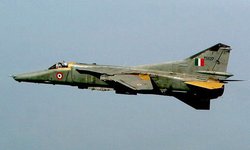Mikoyan-Gurevich MiG-27
|
|
The Mikoyan-Gurevich MiG-27 (NATO reporting name 'Flogger') is a ground attack aircraft, originally built by the Mikoyan-Gurevich Design Bureau in the Soviet Union and later licence-produced in India by Hindustan Aeronautics as the Bahadur ("Valiant"). It is based on the MiG-23 fighter aircraft, but optimized for the air-to-ground role.
Description
The MiG-27 shares the basic airframe of the MiG-23, but with the revised nose (referred to as "Utkanos," duck nose, in Russian service) introduced on the MiG-23B that deletes radar in favor of a downward-sloping profile that improves pilot visibility and contains a laser rangefinder and marked-target seeker. Additional cockpit armor is installed, along with a totally new nav-attack system. Because the MiG-27 is intended to fly most of its missions at low altitude, the fighter's variable intake ramps and exhaust nozzles were deleted in favor of simpler, fixed configuration, reducing weight and maintenance requirement. The aircraft also has larger, heavy-duty landing gear to facilitate operation from poorer airfields.
The initial MiG-27 was known as 'Flogger-D' to NATO. It was subsequently replaced by the upgraded MiG-27D ('Flogger-J'). A later MiG-27M model shared the 'Flogger-D' code, being based on the earlier MiG-23BK, but was actually an upgrade, incorporating a new 30mm GSh-6-30 six-barrel cannon in a fuselage gondola, much improved ECM systems, and a new PrNK-23K nav/attack system providing automatic flight control, gun firing, and weapons release.
The final Soviet version was the MiG-27K, which added a laser designator and compatibility with TV-guided electro-optical weapons. It was designated 'Flogger-J2' by NATO.
Specifications (MiG-27K)
- Crew: one
- Length: 17.1 m (56 ft), including probe
- Wingspan: (spread) 13.8 m (45 ft 3.3 in); (swept) 7.4 m (24 ft 3.3 in)
- Height: 5 m (16 ft 5 in)
- Wing area: (spread) 37.35 m² (402.05 ft²); (swept) 34.16 m² (367.71 ft²)
- Empty: 11,908 kg (26,252 lb)
- Loaded: 18,100 kg (39,903 lb)
- Maximum takeoff: 20,670 kg (45,569 lb)
- Powerplant: 1x Khatchaturov R-29-300 turbojet, rated 8,300 kgf (81 kN (18,300 lbf, military and 12,500 kgf (123 kN, 27,600 lbf) afterburning thrust
- Maximum speed: 1,885 km/h (1,170 mph, Mach 1.77) at 8,000 m (26,250 ft); 1,350 km/h (839 mph, Mach 1.10)) at sea level
- Combat range: 780 km (488 mi)
- Ferry range: 2,500 km (1,553 mi)
- Service ceiling: 14,000 m (45,930 ft)
- Rate of climb: 12,000 m/min (39,370 ft/min)
- Wing loading: 605 kg/m² (123 lb/ft²)
- Thrust/Weight: 0.62:1
- Armament:
- One GSh-6-30 30mm cannon with 260 (some sources say 300) rounds
- One centreline, four fuselage, and two wing glove pylons for a total of 4,000 kg (8,818 lb) of stores, including general-purpose bombs, rocket pods, SPPU-22 and SPPU-6 gun pods, and various guided air-to-surface missiles
| Related content | |
|---|---|
| Related Development | |
| Similar Aircraft | |
| Designation Series |
MiG-21 - MiG-23 - MiG-25 - MiG-27 - MiG-29 - MiG-31 - MiG-33 |
| Related Lists | List of military aircraft of the Soviet Union and the CIS - List of fighter aircraft |
|
Lists of Aircraft | Aircraft manufacturers | Aircraft engines | Aircraft engine manufacturers Airports | Airlines | Air forces | Aircraft weapons | Missiles | Timeline of aviation |

